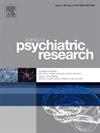Associations between minimally adequate treatment and clinical outcomes among Medicaid-enrolled youth with bipolar disorder
IF 3.7
2区 医学
Q1 PSYCHIATRY
引用次数: 0
Abstract
Objective
To investigate associations between minimally adequate treatment and clinical outcomes among youth with bipolar disorder.
Methods
This study utilized a retrospective cohort of publicly-insured (Medicaid) youth aged 10–18 years with a new bipolar disorder episode between 2009 and 2013 from 15 geographically diverse states. Four minimally adequate treatment measures were evaluated during a 180-day treatment period: 1) Minimally Adequate Pharmacotherapy: medication (mood stabilizer and/or atypical antipsychotic) possession ratio ≥80%; 2) Minimally Adequate Psychotherapy: ≥8 psychotherapy visits; 3) Minimally Adequate Pharmacotherapy and Psychotherapy, and 4) Recommended Pharmacotherapy with No Antidepressant Monotherapy: no antidepressant prescription without a mood stabilizer and/or atypical antipsychotic. Cox proportional hazards models examined associations between minimally adequate care and time to four clinical outcomes: bipolar disorder-related psychiatric hospitalization or emergency room (ER) visits, deliberate self-harm, and all-cause mortality. We estimated average treatment effects (ATE) using propensity score weighting with stabilized ATE weights to control for confounding.
Results
Hazard of hospitalization was increased among youth receiving minimally adequate psychotherapy (HR = 1.23 [95% CI: 1.04–1.44]) and both minimally adequate pharmacotherapy and psychotherapy (HR = 1.48 [95% CI: 1.12–1.96]) and decreased among youth receiving no antidepressant monotherapy (HR = 0.74 [95% CI: 0.62–0.88]). Hazard of ER visits was increased among youth receiving minimally adequate pharmacotherapy (HR = 1.38 [95% CI: 1.14–1.68]), minimally adequate psychotherapy (HR = 1.35 [95% CI: 1.13–1.61]), and both minimally adequate pharmacotherapy and psychotherapy (HR = 1.66 [95% CI: 1.24–2.24]).
Conclusions
Further research is needed to understand why receipt of minimally adequate care is positively associated with increased mental healthcare utilization among youth with new bipolar disorder episodes.
求助全文
约1分钟内获得全文
求助全文
来源期刊

Journal of psychiatric research
医学-精神病学
CiteScore
7.30
自引率
2.10%
发文量
622
审稿时长
130 days
期刊介绍:
Founded in 1961 to report on the latest work in psychiatry and cognate disciplines, the Journal of Psychiatric Research is dedicated to innovative and timely studies of four important areas of research:
(1) clinical studies of all disciplines relating to psychiatric illness, as well as normal human behaviour, including biochemical, physiological, genetic, environmental, social, psychological and epidemiological factors;
(2) basic studies pertaining to psychiatry in such fields as neuropsychopharmacology, neuroendocrinology, electrophysiology, genetics, experimental psychology and epidemiology;
(3) the growing application of clinical laboratory techniques in psychiatry, including imagery and spectroscopy of the brain, molecular biology and computer sciences;
 求助内容:
求助内容: 应助结果提醒方式:
应助结果提醒方式:


